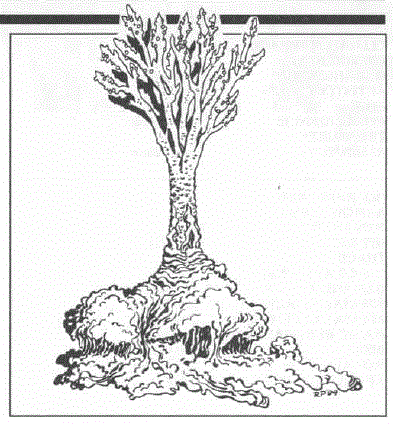
| Climate/Terrain: | The Hive |
|---|---|
| Frequency: | Common |
| Organization: | Special |
| Activity Cycle: | See below |
| Diet: | Waste food and minerals |
| Intelligence: | Nil |
| Treasure: | Nil |
| Alignment: | Nil |
| No. Appearing: | 1 |
| Armor Class: | 9 |
| Movement: | 1 |
| Hit Dice: | 10 |
| THAC0: | 18 |
| No. of Attacks: | 1 |
| Damage/Attack: | 3-24 (3d8) |
| Special Attacks: | Welding torch, etc. |
| Special Defenses: | Nil |
| Magic Resistance: | Nil |
| Size: | S to L (3-8’) |
| Morale: | Average (10) |
| XP Value: | 100 |
An artificial life form created by the mysterious Arcane, this oozing slime maintains the Hive. Its extraordinary threephase life cycle serves different functions within the asteroid complex. These three phases are as follows:
Amoebas: In its basic form, the silver slime is a colony of 10-20,000 inch-long blobs, each weighing about one ounce. These bright silver blobs, or amoebas, scavenge the area in a 1,000‘ radius, eating all organic waste and small mineral particles. The small slimes can be destroyed easily and represent no harm to anything larger than a sand particle. This cleaning phase lasts for one week or until the area is clean, whichever is longer.
Plasmodium (slug): Once the cleaning phase ends, the colony of small slimes draws together over a period of two days, gradually growing into a single large blob, colored dull silver and weighing 500-800 lbs. This slug-like aggregate, called a “plasmodium,” crawls around within an area of one square mile for one week, fixing leaks and repairing breaks.
The plasmodium has the magical ability to form repair tools from its silvery bulk. When it encounters a crack in some object, the creature extends a pseudopod. The pseudopod transforms into the tool needed to fix the crack.
For metal cracks, the pseudopod becomes a welding torch: a flaming wand that burns hot enough to melt and seal metal. For cracks in stone, the pseudopod turns into a trowel, and brushes part of its own substance onto the crack. The slimy material dries hard, sealing the crack. Once the task is complete, the plasmodium reabsorbs the tool.
Sporangia (fruiting bulbs): After one week, or when it has used half of its substance sealing cracks, the plasmodium halts and extrudes a central stalk. The stalk is a light, woodlike substance similar to cork. The slime colony climbs the stalk, extending it and branching as the climb continues, until the stalk resembles a stately tree 20 feet tall. The slime colony becomes 100-400 silvery spheres about 1” in diameter, each hanging from the end of a branch. Each sphere is called a “sporangium.”
For one week, the immobile colony photosynthesizes, taking in carbon dioxide and exhaling oxygen and so refreshing the asteroids air. Then the papery sporangia burst, expelling a cloud of spores 18’ in diameter. The cloud dissipates in two rounds, and the spores drift on air currents to new locations.
There they land, turn into amoebas, and the life cycle begins again.
Combat: The silver slime can be harmed by all attacks, and it inflicts no special damage. The amoeba phase of the silver slime’s life cycle represents no threat to adventurers.
The plasmodium has hit points according to its size, like a deadly pudding. (See “Pudding, Deadly” in the Monstrous Compendium, Volume One.) The plasmodium is not aggressive, but PCs might throw themselves in the path of its repair tools and, by singleminded effort, take damage from it.
The sporangia are not deadly, but they expel their spores when attacked, and PCscaught in the radiusof effect breathe the spores if they fail to save vs. poison. This inflicts 2d4 damage, but has no other ill effects.
Because the silver slime is benign, the XP award for its defeat is low for its size.
Habitat/Society: The Arcane created the silver slime specifically for the Ravager’s asteroid complex. It is found nowhere else, unless the DM decides that an amoeba drifted away from the asteroid, hitched a ride on a passing spelljammer ship, and started a new life cycle elsewhere.
Ecology: The silver slime, a weird collective life form, functions as scavenger, repairman, and air refresher. The colony subsists on organic waste and mineral breakdown products. However, it does not eat the fine stone powder left from the Ravager’s disintegration process.
The slime colony requires a fairly constant temperature, moist conditions, and light no stronger than that in the asteroid complex. In extreme cold or heat, or in dry or bright conditions, the colony aggregates into its plasmodium form, then forms a thick, hard outer covering (AC4). This “macrocyst” stage preserves the colony’s life for up to one century. When conditions return to optimum, the macrocyst coat dissolves and the colony resumes activity.
This slime’s remarkable life cycle is modelled on a real slime mold called Dictyostelium discoideum. For details, look in a good encyclopedia under “Slime Molds.”
